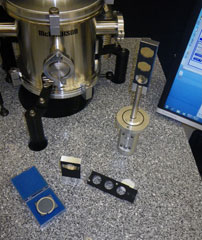
Deep and Vacuum Ultraviolet Spectrophotometer
Do you test transmittance and reflectance in the Vacuum Ultraviolet? Do you provide optics, coatings, photo resist materials, and substrates for the energetic ultraviolet? The VUVAS 1000 directly measures reflectance and transmittance properties of vacuum ultraviolet (VUV) optical components. The VUVAS 1000 system works from 120 to 350 nanometers with high throughput, strong signal levels and excellent reliability. The system uses a high throughput vacuum monochromator, focused light source, a sample chamber capable of holding multiple samples, detectors, and a vacuum pumping (or purge) system. The VUVaS 1000 comes complete with vacuum pump and gauge, or purge-gas system. Easy to use Spectrometer Control Software (LabView™ based) controls automated parameters and signal recovery.
We also build metrology equipment for spectroscopy applications in the soft x-ray (SXR) and extreme ultraviolet (XUV). These are spectrophotometers with optimized optical design and coatings with vacuum or inert gas purge. They easily measure transmission and reflection with goniometric control of sample and detector angles. We can measure reflection coatings and also dispersive optics, like diffraction gratings.
The McPherson XUV Spectrophotometer has been used to characterize optics, filters and detectors for projects like XMM-Newton, the Chandra X-ray Observatory and many more. Scientists like Neil deGrasse Tyson talk about how much “more" there is to see…and different kinds of light are each a tool in the toolbox of astronomy." [Quote from 'Explore the X-ray Universe (4/19)'] In what portion of the electromagnetic spectrum we will be observing the universe next?
VUVAS 1000 | Draft New VUVAS-1000 data sheet | XUV Spectrophotometers |
| Wavelength Range | 120 to 350nm |
| Vacuum Compatible | High vacuum, 10-5 mbar operation |
| N2 Purge System | Optional |
| Precision, RSD (at 157nm) | 0.25% |
| Precision, RSD (overall) | <0.5% |
| Stability (per hour) | 1% |
| Bandpass (adjustable) | 1 to 8nm |
| Calibration accuracy | 0.1nm |
| Wavelength reproducibility | 0.05nm |
| Drive Step Size | 0.00006nm |
| Measurement Beam | Collimated |
| Detector(s) | Scintillated R6095 |
| Detector position | variable from ~10 to 180° |
| Sample position | variable from zero to 60° |
| Qty samples | 3, 5 and other qtys avail. pls inquire |
| Polarizer Mounting | Optional |
| Beam Dia Scaling Aperture | Optional |


This spectra was collected with the single beam VUVAS 1000 spectrophotometer system. Light source is deuterium and scans / data collection occur in 10E-5 mbar vacuum condition
Call 1-978-256-4512 to discuss your application today.